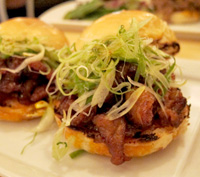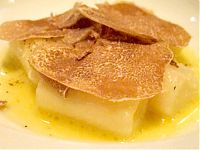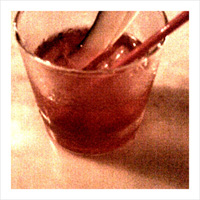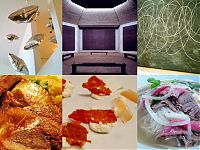Jacques Gautier
by Nancy Matsumoto
September 27, 2011
To enter the charming Park Slope restaurant Palo Santo is to feel you’ve stumbled upon a tropical Bauhaus, a laboratory for artisans. The botanical curves of metal artist Kristina Kozak’s handrail and grill lead up to a pair of century-old wooden doors, which give way to a wonderland of handcrafted furniture, mosaic work, and recycled architectural detailing. Lush greenery and the sound of water trickling down rocks complete this temple to craft, both culinary and decorative.
Although many artists helped Palo Santo’s chef-owner Jacques Gautier fashion the interior, the overarching vision is his own. “I feel there should be a strong connection between décor, food, style of service and restaurant concept,” says Gautier. I wanted my place to show that our influences came from Latin American markets. We put a lot of care into carefully selecting and making everything handmade.”
Although Gautier grew up in Washington, D.C., his love for Latin America began early, through frequent travels in the region with his Haitian father, an interpreter for the Organization of American States. It was those traveling and eating experiences — and a Delaware-born mom who grew her own vegetables — that most influenced the chef’s tastes. A vegetarian between the ages of 14 and 19, he trained at Manhattan’s Natural Gourmet Institute, then picked up skills in a variety of cooking styles in the kitchens of the Williamsburg Italian favorite, Brick Oven Gallery; at Jean-Georges Vongerichten’s landmark Thai restaurant, Vong; and at Soho’s New American cuisine standby Zoë. Before opening Palo Santo in 2006, Gautier spent a year visiting markets throughout Latin America.
His various New York restaurant experiences taught him that there is a certain sameness — of technique and menu composition — to New York City cooking that is stronger than any ethnic differences they might tout. “At Palo Santo,” he says, “I wanted to get away from that sameness and do my own thing.”
Gautier’s cuisine highlights produce from Palo Santo’s rooftop garden, local green markets and tropical favorites. Among the latter are Haitian mangoes and papaya (for hot sauces and sorbets), avocado (at the moment, for chilled soups), avocado leaves (similar to bay leaves, for seasoning), and green coconuts (for their water and as serving vessels). Everything on the menu, from salsas and chimichurris to black beans and corn tortillas, is homemade and delicious. “The most challenging part is getting through all of the PR, bookkeeping and paperwork,” Gautier says. “I really don’t find them as interesting as cooking.”



















